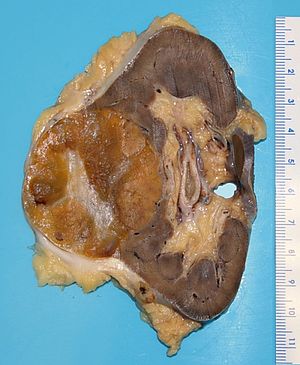Total nephrectomy for tumour grossing
This article deals with the cut-up of total nephrectomy for tumour specimens. It also includes radical nephrectomy with or without an adrenal gland.

A kidney tumour (renal oncocytoma) at the time of grossing.
Partial nephrectomy specimens and nephroureterectomy specimens are dealt with separately.
Introduction
Nephrectomies are often done for kidney tumours.
They come in three basics flavours:
- Partial nephrectomy.
- Total nephrectomy.
- Radical nephrectomy - includes Gerota's fascia.
- Gerota's fascia is the fascia overlying the perinephric fat).
Resections for tumours generally are radical nephrectomies or partial nephrectomies.
Specimen opening
- Paint surface of specimen (optional).
- Take margins - renal artery, renal vein, ureter (all en face) and place all three in one tissue cassette.
- Place probes in the renal vein.
- One toward upper pole.
- One toward lower pole.
- Cut the kidney in the frontal plane (from medial to lateral) using the two probes as a guide.
- The cut should open the renal vein and its major tributaries.
Opening notes
- It is reasonable to skip the inking step as if the tumour is at the surface it is usually obvious.
Protocol
Dimensions, weight and inking:
- Type: [total nephrectomy/radical nephrectomy].
- Laterality: [left / right].
- Weight: ___ grams.
- Size of specimen (superior-inferior, left-right, anterior-posterior): ___ x ___ x ___ cm.
- Ureter (length x diameter): ___ x ___ cm.
- Renal vein (length x diameter): ___ x ___ cm.
- Renal artery (length x diameter): ___ x ___ cm.
- Adrenal gland: [___ x ___ x ___ cm / not identified].
- Inking of surface: [colour].
- Size of kidney (superior-inferior, left-right, anterior-posterior): ___ x ___ x ___ cm.
- Perinephric fat (maximal dimension): ___ cm.
Tumour:
- Dimensions (superior-inferior, left-right, anterior-posterior): ___ x ___ x ___ cm.
- Location: [upper pole / mid / lower pole].
- Colour: [yellow / tan / white].
- Morphology: [solid / cystic / solid and cystic - with ___ % cystic].
- Friability: [friable / not friable].
- Circumscription: [well circumscribed / indeterminate / infiltrative border].
- Hemorrhage: [present / absent].
- Necrosis: [present / absent].
- Margin: [nearest margin ___, distance ___ cm / positive margin, location ___].
- Extension into perinephric fat: [absent / not identified-pushing border / suspicious / present].
- Extension into renal sinus fat: [absent / not identified-pushing border / suspicious / present].
- Extension into the collecting system: [absent / suspicious / present].
- Extension into renal vein: [absent / suspicious / present].
Other:
- Non-tumour parenchyma: [cortex unremarkable / thinned].
- Collecting system mucosa: [smooth and regular / granular / irregular / dilated].
- Lymph nodes: [number of lymph nodes with [unremarkable cut surface / tumour] / not identified].
Representative sections are submitted:
- Renal vein margin. ‡
- Ureter margin and renal artery margin.
- Tumour with nearest margin.
- Tumour and perinephric fat. †
- Tumour and sinus fat. †
- Normal kidney.
- Adrenal gland.
Protocol notes
- Tumour stage size cut points: <=4 cm, <=7 cm.
- The 7th edition of the TNM staging system divides pT2 into pT2a (>7 cm and <=10 cm) and pT2b (>10 cm); however, evidence does not support this subdivision.[1]
- ‡ It is important to sample the renal vein wall if tumour thrombus projecting out of the renal vein, as a positive margin is called based on microscopic involvement of/adherence to the vein wall.[2]
- Tumour projecting out of the vein (i.e. at the surface of specimen), at the time of grossing, is presumed to be due to retraction of the vein after it is cut.
- † If fat invasion obvious = 1 section.
- Suspicion of fat invasion = 3 sections.
Alternate approaches
See also
Related protocols
References
- ↑ Waalkes, S.; Becker, F.; Schrader, AJ.; Janssen, M.; Wegener, G.; Merseburger, AS.; Schrader, M.; Hofmann, R. et al. (Feb 2011). "Is there a need to further subclassify pT2 renal cell cancers as implemented by the revised 7th TNM version?". Eur Urol 59 (2): 258-63. doi:10.1016/j.eururo.2010.10.005. PMID 21030143.
- ↑ Trpkov, K.; Grignon, DJ.; Bonsib, SM.; Amin, MB.; Billis, A.; Lopez-Beltran, A.; Samaratunga, H.; Tamboli, P. et al. (Oct 2013). "Handling and staging of renal cell carcinoma: the International Society of Urological Pathology Consensus (ISUP) conference recommendations.". Am J Surg Pathol 37 (10): 1505-17. doi:10.1097/PAS.0b013e31829a85d0. PMID 24025521.